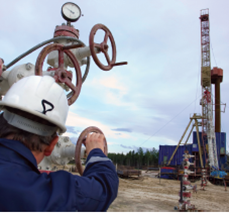At the end of last month, we saw yet another casualty in the Trump administration’s war on science-based policy. The administration announced it would rescind a 2015 rule at the Bureau of Land Management (BLM) to address risks associated with unconventional oil and gas development on public land. Though not unexpected, this move was disheartening. The 2015 BLM fracking rule was an important step in protecting people from many unchecked risks associated with hydraulic fracturing. To understand what we lost, let me quickly review the national setting back in 2015 when the rule was issued.

The BLM fracking rule, rescinded by the Trump Administration, was the only major federal rule governing risks associated with unconventional oil and gas development. Photo: Shutterstock.com/krivenko
A Wild West of oil and gas drilling
Around 2008, the oil and gas industry refined methods of hydraulic fracturing combined with horizontal drilling that made the process of shale oil and gas drilling more economically viable. This led to a rapid expansion of oil and gas development across the country. Many of the new places seeing oil and gas development had never experienced drilling in close proximity before, and now it was happening around them—in some cases, literally in their backyards. The nation was caught off guard. Notably, the scientific community had to play catch-up to assess risks to air and water and from occupational chemical exposure. Reports began to surface from communities complaining of drinking water contamination or poor air quality causing health concerns. But scientific studies on these subjects were limited.
One major barrier to understanding the risks associated with the new boom in fracking was a lack of transparency from industry. Researchers studying air quality around facilities were only able to take measurements from facility fencelines without closer access to emission sources on site. Researchers studying water quality were forced to analyze samples without any baseline measurements of what water quality was like before drilling started. And physicians were forced to make medical decisions about patients without knowledge of the chemicals they were exposed to because companies refused to disclose chemicals used in fracking fluid.
As a result, the public was left in the dark. The federal government failed to take a large role in regulating this Wild West of oil and gas drilling, leaving regulation largely up to states—many of which were ill-equipped to manage a new and complex industry now ever-present in their state. In some ways the federal government was limited in what it could do. The infamous “Halliburton Loophole” in the Safe Drinking Water Act prevents the EPA from protecting people from fracking risks to drinking water using the Safe Drinking Water Act.
The BLM fracking rule: the federal government steps up
But one way the federal government could take action (or at least so they thought) was by creating a rule dictating how unconventional oil and gas drilling could happen on public lands. Thus, the BLM fracking rule was developed. While modest in scope, the BLM rule was an important step toward greater regulation and disclosure of an industry unaccustomed to playing under such constraints. The rule set standards for well construction, wastewater management, and chemical disclosure. The greater chemical disclosure requirement was huge. It meant companies couldn’t continue to hide behind trade secret claims and the public, scientists, landowners, medical personnel, workers, and first responders would now have greater access to information about chemicals involved and risks to health.
The rule’s requirements about well construction and wastewater management could also have gone a long way toward minimizing risks of groundwater contamination—perhaps the issue of greatest concern for communities based on several high-profile cases of large-scale drinking water contamination. This is an area where we also saw a high degree of industry misconduct. There were cases of dumping wastewater and many accidental spills and leaks. In other cases, water was contaminated by faulty well-casings or natural and manmade fissures in bedrock that allowed fracking chemicals or naturally occurring hazardous chemicals to reach water sources. All the while, industry often hid behind their narrow definition of fracking, despite a public understanding and concern about water contamination throughout the process—from initial drilling, to oil and gas production, to transportation from the site. Setting standards, even if only for public lands, could have encouraged companies to adopt such protocols industry-wide, guarding against future water contamination.
The rule also restricted where drilling could happen. It required companies to avoid endangered species habitats. This was important for species like the sage grouse which live in prime areas for development and need quiet spaces for mating. (Side note: This is actually one of three hits on the sage grouse by the Trump Administration. Earlier this year it reopened state management plans that were designed to ensure the species could stay off of the endangered species list. And last week, the administration rescinded an order for the BLM to prioritize oil and gas permit granting outside of sensitive sage grouse territory.)
Back to square one: leaving us in the dark
Though the rule was stayed by a court in 2016 and thus wasn’t in effect when the Trump Administration made this move, the rule did sent a signal to industry that they would soon have to accept a more transparent and safety-focused business model. Without such a rule on the books, we are now back to square one when it comes to federal protection of people against the risks of fracking. And that leaves us all in the dark.

